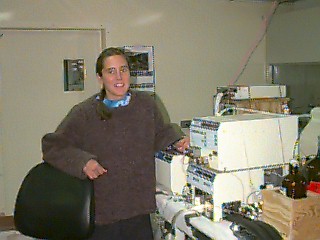
|
|
4 February, 1998
Gould-en Greetings!
Today I received my own experiment that I will be starting tomorrow. This
will be a component of the study of oxygen that I alone will be responsible
for doing. Last summer, Dr. Karl and I had discussed my doing a study on
the relationship of size of cyanobacteria (bluegreen algae) to its
productivity. However, it appears that an algae bloom has not occurred in
the areas that we have tested so far. Also, since I have been working with
dissolved oxygen testing, it made more sense to involve me in a study of
that bio nutrient. More details tomorrow. Tonight I have to practice my
technique as it is easy to get false data from samples poorly collected.
Of course, all of these studies are intended to compliment and augment each
other. Wendy Kozlowski is the Field Team Leader for PI Maria Bernet of
University of California San Diego / Scripps Institute of Oceanography.
She and others on her team, such as Mike Crowder, Karie Sines, and Marnie
Zirbel, are working on the phytoplankton (small photosynthetic organisms
floating in water) ecology component of LTER. The big picture of what they
are doing is relating pack ice to how it affects phytoplankton and the
regular seasonal variability of phytoplankton cycles. It is more of a
monitoring project to get baseline data to see if changes are short
anomalies (unusual occurrences) or actual long-term trends. The work takes
in consideration data that other studies, such as the bioptics by PI Dr.
Smith and the carbon fluxes by PI Dr. Karl, collect at the same time to
make a total picture all of the biological processes. Such things as
pigment analysis which utilizes the "signature" of groups of pigments found
in each of the different species of phytoplankton, help Wendy know the
numbers and species of organisms present by the ratio of pigments
indicated. The seasons are short here and activity occurs only in brief
pulses, so data must be collected to take advantage of the correct timing.
Wendy has been doing this for 4 seasons now, so it means that she has had
to be here in the austral summer 4 years in a row from October through
March. Christmas away from family has been the hardest part of the whole
deal, but she remains positive and enthusiastic about the field work.
How would having the bioptics state that the readings indicate very clear
water likely affect the oxygen production? What are the needs of
phytoplankton to have high productivity of oxygen? What does high
productivity indicate what is happening with the phytoplankton in regard to
nutrients? Stay tuned to this channel - answers tomorrow!
Warm regards,
Mrs. D

Contact the TEA in the field at
.
If you cannot connect through your browser, copy the
TEA's e-mail address in the "To:" line of
your favorite e-mail package.
|
